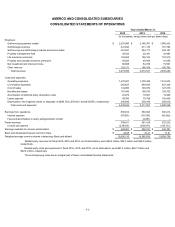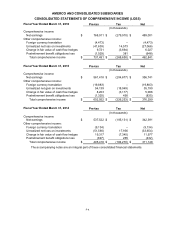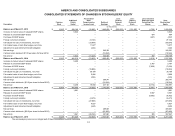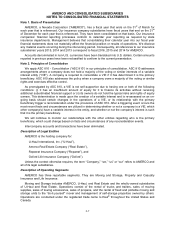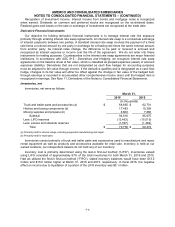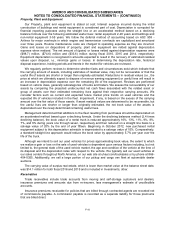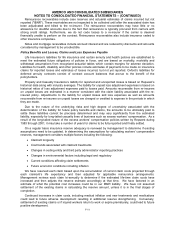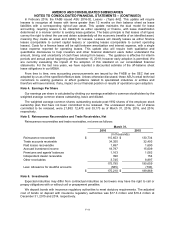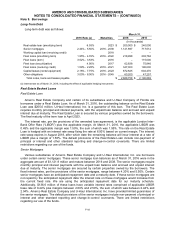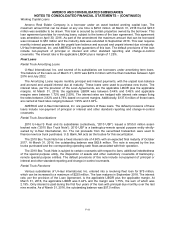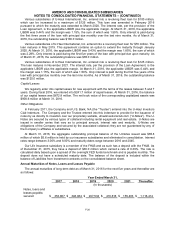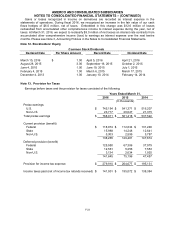U-Haul 2016 Annual Report Download - page 69
Download and view the complete annual report
Please find page 69 of the 2016 U-Haul annual report below. You can navigate through the pages in the report by either clicking on the pages listed below, or by using the keyword search tool below to find specific information within the annual report.AMERCO AND CONSOLIDATED SUBSIDIARIES
NOTES TO CONSOLIDATED FINANCIAL STATEMENTS – (CONTINUED)
F-13
Income Taxes
AMERCO files a consolidated tax return with all of its legal subsidiaries. In accordance with ASC 740 -
Income Taxes (“ASC 740”), the provision for income taxes reflects deferred income taxes resulting from
changes in temporary differences between the tax basis of assets and liabilities and their reported
amounts in the financial statements.
Comprehensive Income (Loss)
Comprehensive income (loss) consists of net earnings, foreign currency translation adjustments,
unrealized gains and losses on investments, the change in fair value of cash flow hedges and the change
in postretirement benefit obligations.
Recent Accounting Pronouncements
In May 2014, the Financial Accounting Standards Board (“FASB”) issued Accounting Standards
Update (“ASU”) 2014-09, Revenue from Contracts with Customers, an updated standard on revenue
recognition. The standard creates a five-step model for revenue recognition that requires companies to
exercise judgment when considering contract terms and relevant facts and circumstances. The standard
requires expanded disclosure surrounding revenue recognition. Early application is not permitted. The
standard is effective for fiscal periods beginning after December 15, 2016 and allows for either full
retrospective or modified retrospective adoption. In July 2015, the FASB issued ASU 2015-14, Revenue
from Contracts with Customers, Deferral of Effective Date, which delays the effective date of ASU 2014-
09 by one year to fiscal periods beginning after December 15, 2017. In March 2016, the FASB issued
ASU 2016-08, Revenue from Contracts with Customers, Principal versus Agent Considerations
(Reporting Revenue Gross versus Net), which is intended to improve the operability and understandability
of the implementation guidance on principal versus agent considerations and the effective date is the
same as requirements in ASU 2015-14. We are currently evaluating the impact of the adoption of this
standard on our consolidated financial statements.
In March 2015, the FASB issued ASU 2015-03, Simplifying the Presentation of Debt Issuance Costs.
The amendments in this update require that debt issuance costs related to a recognized debt liability be
presented in the balance sheet as a direct deduction from the carrying amount of that debt liability,
consistent with debt discounts. The recognition and measurement guidance for debt issuance costs are
not affected by the amendments in this update. The guidance is effective for interim periods and annual
period beginning after December 15, 2015; however early adoption is permitted. The adoption of this
standard is not expected to have a material impact on our consolidated financial statements.
In January 2016, the FASB issued ASU 2016-01, Financial Instruments – Overall (subtopic 825-10):
Recognition and Measurement of Financial Assets and Financial Liabilities. ASU 2016-01 addresses
certain aspects of recognition, measurement, presentation, and disclosure of financial instruments.
Among other provisions, the new guidance requires the fair value measurement of investments in certain
equity securities. For investments without readily determinable fair values, entities have the option to
either measure these investments at fair value or at cost adjusted for changes in observable prices minus
impairment. All changes in measurement will be recognized in net income. The guidance is effective for
interim periods and annual period beginning after December 15, 2017. Early adoption is not permitted,
except for certain provisions relating to financial liabilities. We are currently evaluating the impact of the
adoption of this standard on our consolidated financial statements.


